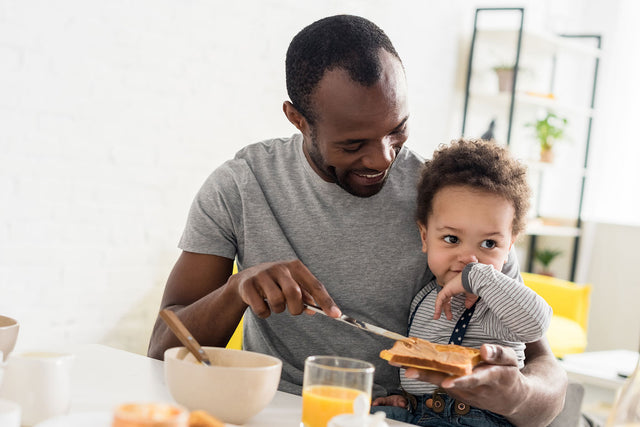When Can Babies Have Peanut Butter?

Food allergies can be a scary part of introducing solids to your baby. And, there’s controversy around when to try out foods that are well known to provoke allergic responses like eggs, strawberries and - the much-feared - peanut!
In fact, you may have heard that you should totally steer your child clear of peanuts (butter, crumbles, candy, etc.) for the first few years. That advice actually seems to make good sense: let your child’s intestinal protections get a bit stronger before an exposure to strong allergens. But, it’s actually now recognized to be completely wrong!
The National Institute of Health (NIH) advises giving peanut-containing food to babies in the first year. Even more surprising…the higher risk your child has of allergy, the earlier the NIH recommends try peanuts.
LEAP Study on Peanut Exposure in Babies
The NIH based its new guidelines on King’s College London’s landmark LEAP study (Learning Early About Peanut Allergy) which studied over 600 high-risk infants. Much to their surprise, the doctors found that an early introduction to peanut-containing foods significantly reduced peanut reactions in allergy-inclined babies.
When to Introduce Peanut Butter to Your Baby
Babies with No Peanut or Food Allergies
Babies who have no allergies, eczema or strong family history can try peanuts during the early introduction of solid foods. Just don’t make PB&J their first regular meal. Even low risk babies should not launch into gastronomy with peanuts as their first appetizer.
Babies at Risk of Peanut and Food Allergies
The NIH recommends babies with mild-to-moderate eczema have peanuts added to their diet at 6 months.
For children with “high risk”— because of eczema, egg allergy or some other allergic issue—doctors now recommend exposing them to peanuts even earlier, at 4-6 months!
But don’t take our word for it! Every child is unique, so it is very important that your pediatrician be the one deciding if, when and how to introduce high allergy foods. In fact, many infants are also referred to allergy specialists for screening lab tests – like a scratch test or blood work - to create the best, safest plan.
Can Babies Outgrow a Peanut Allergy?
Growing out of a peanut allergy is not very common. In fact, only about 20% of babies outgrow peanut allergies.
How to Introduce Your Baby to Peanut Butter
To be clear, you should never crack a shell and hand a peanut over to a little baby—whole peanuts and even small chunks are a dangerous choking hazard. Inhaling a piece of peanut usually requires emergency anesthesia and removal! Even a spoonful of peanut butter can be risky because its thick, sticky consistency can make it hard to swallow.
How Much Peanut Butter Can a Baby Have
The American College of Allergy, Asthma and Immunology recommends mixing 2 tbs. of smooth (not chunky) peanut butter with hot water to make a thin, baby-friendly goo…and then mixing that with pureed fruits or veggies to thin it even more. Try out just a small spoonful, then watch your baby for 10 minutes for signs of a reaction. Peanut allergies are pretty quick to show up, but make sure to look out for the following signs of a peanut allergy.
Signs of Peanut Allergy in Babies
- vomiting
- hives
- redness or swelling of the face and tongue
If all goes well, you can try it again the next day.
Of course, every baby is different. Before introducing peanuts or peanut butter, be sure to ask your doctor what’s best for your baby.
Note: Also ask your doctor or nurse practitioner if you should buy some liquid Benadryl to keep in your first aid kit. It can come in very handy in case of a sudden allergic reaction – like to a bee sting - at home and on trips.
Revised on September 10, 2019